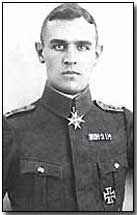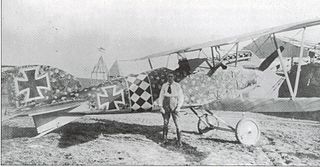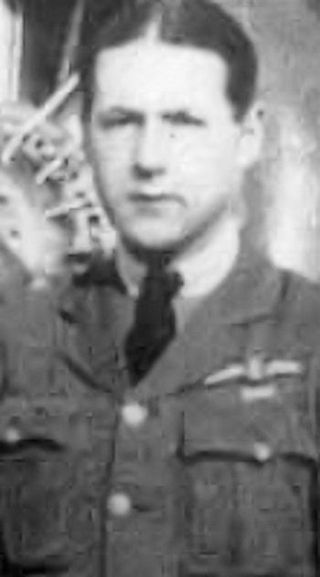Related Research Articles

Franz Büchner PlM was one of the most successful German fighter aces of the First World War, shooting down 40 enemy aircraft. He began his military career as a 16-year-old infantryman. His doughty exploits earned him a battlefield commission just after his 18th birthday, in early 1916. After being wounded and invalided from the infantry, he joined the Imperial German Air Service. Once he progressed to become a fighter pilot flying a Fokker D.VII, he initially struggled to gain his first aerial victories. Something clicked after his fifth victory, and he began to regularly shoot down enemy airplanes, scoring 35 victories between 1 July and 22 October 1918. Most notably, he shot down four SPADs on 26 September. He survived the war, but died in action in 1920 while combating communist revolutionaries near Leipzig.
Hans Kirschstein, winner of the Pour le Merite, Royal House Order of Hohenzollern, and the Iron Cross, 1st and 2nd class, was a German lieutenant and World War I flying ace credited with 27 aerial victories.
Friedrich Altemeier was a German World War I flying ace credited with 21 confirmed aerial victories. Due to his distinguished faithful military service and piloting skills, he became one of the test pilots for Germany's last and best fighter airplane of the war, the Fokker D.VIII.
Leutnant zur SeeWilhelm Thöne was a German World War I flying ace credited with six aerial victories.
Vizeflugmeister Hans Goerth was a World War I German flying ace credited with seven confirmed aerial victories. He was the top ace of Marine Feld Jasta III of the German Naval Air Service, and was one of the few aces allowed to fly the Fokker E.V monoplane. Goerth received the Iron Cross First Class and other awards for his service. After the war, in 1919, the pilot participated in Kampfgeschwader Sachsenberg, commanded by fellow World War I ace Gotthard Sachsenberg.
Oberleutnant Hans Kummetz was a World War I flying ace credited with seven aerial victories.
Leutnant Josef Raesch was a World War I flying ace credited with seven aerial victories. Two of his victories were over other aces, Guy Wareing and Ernest Charles Hoy.
Major Karl Waldemar Ritscherle was a World War I flying ace credited with eight aerial victories. He served again in the World War II Luftwaffe, and was killed in action when his Heinkel 111 was shot down and fell into Abberton Reservoir.
Oberflugmeister Karl Meyer was a German World War I flying ace credited with eight aerial victories. He was Germany's first naval ace, and one of the few German two-seater aces.

VizefeldwebelFritz John Jacobsen was a German World War I flying ace credited with eight confirmed and two unconfirmed aerial victories.
Unteroffizier Paul Hüttenrauch was a World War I flying ace credited with eight aerial victories.

OffizierstellvertreterWilhelm Hippert IC was a World War I flying ace credited with eight confirmed aerial victories.
LeutnantFranz Hemer was a World War I flying ace credited with 18 aerial victories.
LeutnantRudolf Klimke IC was a German World War flying ace credited with 17 confirmed and two unconfirmed aerial victories. Serving initially as a bomber pilot, his aggressiveness in bombing England, and in shooting down a couple of enemy airplanes got him reassigned to a fighter squadron. After a string of a dozen victories during 1918, he was wounded in action on 21 September 1918.
Leutnant Karl Plauth was a German World War I flying ace credited with 17 aerial victories. He would crash a Junkers A 32 to his death on a test flight.
LeutnantHans Weiss was a World War I flying ace credited with 16 aerial victories.
Leutnant Viktor von Pressentin von Rautter was a German World War I flying ace credited with 15 aerial victories.
Leutnant Walter Göttsch HoH, IC was a German World War I flying ace credited with 20 aerial victories. His final combat assignment was commanding Jagdstaffel 19 in Jagdgeschwader II.
OffizierstellvertreterOtto Esswein was a German World War I flying ace credited with twelve aerial victories.

Lieutenant Kenneth Russell Unger was an American World War I flying ace credited with fourteen aerial victories. His candidacy rejected by his own nation, Unger applied to the British Royal Flying Corps for military pilot training in June 1917. Once trained, he was assigned to the Royal Naval Air Service (RNAS). As the RNAS was merged into the Royal Air Force, Unger scored his aerial victories between 26 June and 1 November 1918. In later life, Unger remained involved in aviation and served again during World War II. He also joined the U.S. Navy Reserves, rising to the rank of rear admiral.
References
- Norman Franks, Frank W. Bailey, Russell Guest. Above the Lines: The Aces and Fighter Units of the German Air Service, Naval Air Service and Flanders Marine Corps, 1914–1918. Grub Street, 1993. ISBN 0-948817-73-9, ISBN 978-0-948817-73-1.